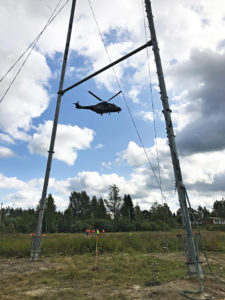The Jäätyvä 2017 exercise simulated a situation in which weather conditions cause an exceptionally long-lasting disturbance in electricity distribution in the main grid and distribution grids. The disturbance paralyses the basic functions of society in the Savon Voima Verkko and Kuopion Sähköverkko distribution areas in the Northern Savonia region. Approximately 400 people took part in the exercise.
The exercise was carried out with a system that resembled a gaming platform. The organisations participated in the game from their own locations, as would be the case in a real situation. Development of the events began the previous week, when the participants received weather bulletins and other situational reports.
A blackout in the whole region
The exercise culminated with an intensive period on 4–5 October, which involved going through two weeks of events in a two-day period. According to the scenario, the electricity was cut off in a large area of Northern Savonia during this period. According to Control Room Manager Arto Pahkin from Fingrid, it’s very important to get an overall picture right at the start.
“The time when information flow stops and the electricity goes off is a critical phase. That’s when we have to cooperate with different organisations to prioritise the importance of repair work. This is challenging when normal communication tools are not functioning.”
The Virve authority radio network and Krivat service platform for critical infrastructure organisations were tested in the exercise.
“It’s good to find out what happens when electricity grids, mobile phone networks and e-mail are not functioning. As far as I know, the Virve and Krivat systems have never been used so extensively in the Kuopio area,” stated Kuopion Sähköverkko Oy’s Managing Director Kari Väänänen.
Operations Manager Simo Hyvärinen confirmed that message traffic worked surprisingly well.
“We noticed that carefully considered and appropriate communication is important. Unnecessary traffic has to be avoided in order to keep the network operating. This require good and clear rules.”
Kuopio and Siilinjärvi wanted to find out if their preparedness is sufficient
The Jäätyvä 2017 exercise was also a test run related to preparedness planning for the cities of Kuopio and Siilinjärvi. The city of Kuopio had a major role in the exercise: approximately 120 employees from the city and its public utilities took part in the project. Deputy Mayor Jarmo Pirhonen said that he is particularly concerned about the level of preparedness on the part of citizens.
“The exercise demonstrated that society is incredibly dependent on electricity. It makes you think about whether residents really know how to prepare for a longer outage. Proper preparation means having enough wood, food, water and batteries for a radio.”
Technical Manager Ari Kainulainen from the municipality of Siilinjärvi also wonders how residents will manage.
“We made evacuation plans during the exercise, but they only apply to citizens who are in poor condition. What will happen to the large numbers of people who live in their own homes? Today’s apartment buildings don’t have back-up heating systems.”
Head of Safety and Security Lauri Holappa from the city of Kuopio said that the exercise provided some good tips for communicating with citizens. “The exercise also showed us that the roles and tasks of the responsible persons have to be clarified. We will also continue the exercises for the other personnel.”
Lights on – electricity is restored

On Thursday, the worst part of the exercise scenario was coming to an end. Repairs were in progress. The Finnish Defence Forces had provided a helicopter. The command centre jubilantly watched a video of the helicopter raising a fallen tower. In fact, the video had been recorded earlier during a practice situation.
Although no people or equipment were physically moved around, the exercise involved responding to requests and used realistic estimates of the times required to complete each action. Captain Mikko Suihkonen from the Finnish Defence Forces was on site in the command centre.
“It was very useful to be able to practice with the operators that would be involved in a real situation. Our job mainly involves providing assistance to other authorities: traffic control tasks, different types of transportation and fuel distribution.”
The exercise provided valuable information
Project Manager Harri Forsberg from the South Savo Rescue Department was responsible for technical operations in the exercise. He was one of the few people who knew in advance how events would progress. The command centre for the exercise sent pre-planned feeds to the players, to which they had to react according to their organisation’s plans. Just like in a real situation, all the parties did not receive all of the messages.
“Although this was an exercise, the situation did correspond to reality to a certain extent. For example, early in the week we provided information about the snow situation. As would be the case in real life, the organisations tried to develop a situational picture using the limited methods that were available.”
“All message traffic during the exercise was saved in the system. This material will be analysed and will certainly provide a lot of information about development needs,” states Harri Forsberg when discussing future plans.
A rough picture of future focuses was already forming as soon as the exercise ended. New questions also came up. Arto Pahkin considered the role of state administration.
“It’s a bit unclear how we can get state administration assistance in a situation that is not yet extreme.” A widespread, two-week regional disturbance is not classified as an emergency. It would be good to have clear rules for this.
“A second important task is to plan how human resources can be used in an exceptional situation. The same people can’t be on call very long when the assignment requires a continuous presence.”
All parties involved agree that cooperation preparedness between organisations has to be improved. However, the situation is not hopeless and many good things were also discovered.
“The exercise showed that different organisations can perform as they should. We obtained good information about how to build functional cooperation,” sums up Pahkin.
Petri Nieminen from the National Emergency Supply Agency chaired the steering group for the exercise, and he was very pleased with the system that served as a platform for the exercise.
“The system operated in an outstanding manner even though there was a lot of traffic. A couple of thousand messages were sent between different parties during the situation. •
The exercise tested six areas:
• Adequacy of resources and equipment for repairing faults
• Use of executive assistance
• Municipal management group activities
• Securing fuel distribution
• Implementation of the electricity restoration sequence
• Communications
The National Emergency Supply Agency’s Power and District Heating Pool was responsible for implementing the exercise, which tested the preparedness and cooperation capacity of different organisations. The parties involved were the transmission system operator Fingrid Oyj, National Emergency Supply Agency, Finnish Defence Forces, Municipality of Siilinjärvi, City of Kuopio, Savon Voima Verkko Oy electricity distribution company, Kuopion Sähköverkko Oy electricity distribution company, Kuopion Vesi water works, North Savo Emergency Department, South Savo Emergency Department, and many other authorities and companies.






